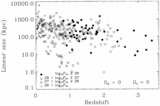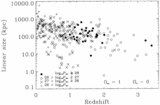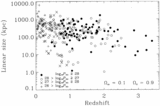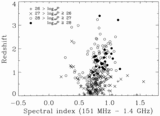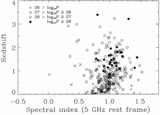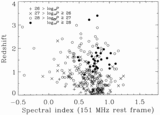Image Details

Caption: Fig. 14.
We overlay on this plot the tracks through the P‐D plane of five sources (upper to lower) with Q0 = 5 × 1038 W at z = 3, Q0 = 2 × 1038 W at z = 1.5, Q0 = 2 × 1038 W at z = 2.5, Q0 = 1 × 1038 W at z = 0.8, and Q0 = 5 × 1037 W at z = 0.5. The leftmost light‐gray bar indicates that for an object to be brighter than the flux limit of the 7C sample (0.5 Jy), if it is at z > 2 then its luminosity must be in the range indicated by the bar; the corresponding bars going to lower luminosities are for the lower redshifts 1.5, 0.8, and 0.5, respectively. The solid lines of the tracks become dotted when the luminosity and redshift of that source are such that they fall below the survey flux limit of 0.5 Jy. The larger symbols in this plot show the rest‐frame luminosities at 151 MHz of members of the 7C complete sample (§ 3.3) against their projected linear sizes. Small dots lie on the tracks to indicate the times 1, 10, 20, ... , 100, 200 Myr through the source's life. It can be seen that because the tracks of the more powerful, higher redshift sources become steeper, and because of the consequences of the flux limit, these sources fall below a survey flux limit at an earlier stage in their lives than do sources at lower power and redshift. The same environment and value of c1 are assumed as for Fig. 13.
Copyright and Terms & Conditions
© 1999. The American Astronomical Society. All rights reserved. Printed in U.S.A.




